© Steven J. Cary, May 31, 2024
Somehow it came to be June. How did that happen? Am I misreading my calendar? Is the summer solstice less than three weeks away? What happened to spring? Time passes, and the busier one is, the faster it goes. This month we have an announcement, a nice story about Stanfords’ Blue by Joshua C’deBaca, and a couple travel stories from yours truly.
The Announcement. Are you passionate about identifying butterflies? The Museum of Southwestern Biology’s Division of Arthropods could use your help! Located at UNM, the collection is home to more than 100,000 insects collected over the past decades. Many of these organisms are butterflies which have yet to be identified! The collection is looking for passionate volunteers who may want to come help identify these specimens in the collection and add to our knowledge of New Mexico Butterflies. If you are interested, please contact Simon Doneski (sdoneski@unm.edu).
Finding Stanfords’ Blue by Joshua C’deBaca. When Mike Anderson found Stanfords’ Blue (Eriogonum stanfordorum) at Jackson Lake last May, the sighting attracted the attention of multiple New Mexico butterfly enthusiasts, including myself. It was one of very few records of the species from the state, and at the time it had only 13 observations on the citizen science website iNaturalist, none from New Mexico. There was also only one other record of it from the whole country on ButterfliesandMoths.org. This year I decided to try to find it myself. I did a bit of research and read on the Butterflies of New Mexico website that the flight period starts in early May, so on May 13th I drove up to San Juan County.
The first place I checked was Jackson Lake, since that was where it was found last year. It was a warm day, and it seemed very dry at first, but on closer inspection many plants were flowering among the crispy grasses. However, I only found about five Eriogonum ovalifolium plants, which is the host plant for Stanford’s Blue. I checked each of the spherical flowerheads multiple times while I was there but didn’t find any blues. There were very few butterflies in general, though I did find a Strecker’s Giant-Skipper, which for me was just as exciting as the blue!
After a few hours, I moved on to my last stop for the day, a spot called Brown Springs Campground, which is a few miles east of Jackson Lake. Brown Springs is in an open juniper woodland on sandy soil. I had originally planned to go there just to look for some endemic plants, mainly Asclepias sanjuanensis (aka San Juan milkweed, which I did end up finding), but when I was doing research on where to look for it, I noticed that Eriogonum ovalifolium had been found at the campground as well, so I thought I might be able to find Stanfords’ Blue there. I parked on the road leading up to the campground and started looking nearby, and immediately found multiple E. ovalifolium plants, and after less than five minutes of walking around I spotted a blue on one of them. I was able to get a quick photo before it flew off, just good enough to tell it was a Stanfords’! I was very excited, but also somewhat disappointed by my single poor photo. Thankfully I found another one (probably the same individual that I saw before) feeding on a nearby buckwheat, and it was very confiding and let me get many close-up photos. I photographed it for several minutes before it flew off.

I’m very happy I was able to find another location for this rare butterfly, and to get great views of such a fantastic species. Hopefully more butterfliers will get out to this underrated part of New Mexico and find other populations, since there is surely a lot more to be found out there.
For my first story (or maybe snory) let me tell you about a March-April 2024 trip to Arizona and California by Marcy and me. A south-bound trailer camping trip to force an early end to winter has become an annual tradition for us. The combination of warm (or at least not cold) temperatures, friends, family, wildflowers, hikeable mountains and new butterflies continues to draw us to southern Arizona and southern California. Okay, I can’t deny it, we have become snowbirds. Who would have thunk it?
We departed on March 19 and drove I-40 to Winslow, AZ, then overnighted at Homolovi State Park, conveniently located a mile or two north of town. The next day we quickly made Flagstaff. Interstate highways have their good and bad points, and by this time we had had enough. So instead of the standard I-17 descent off the Mogollon Rim, we decided to go south and descend via State Highway 89A. That must be quite a joyride in a sporty vehicle, because those hairpin turns were very tight. Pulling a trailer, however, was quite a white-knuckle affair. We managed okay, but it really got our attention. Dead Horse Ranch State Park is situated along the Verde River near Cottonwood, below the Mogollon Rim in Yavapai County, AZ. We planned to stay three days to do some exploratory hikes in the red-rock landscapes south of Sedona. We also hoped to spend some quality time on the trail and around the campfire with comrades Kathy, Rich and Viva.
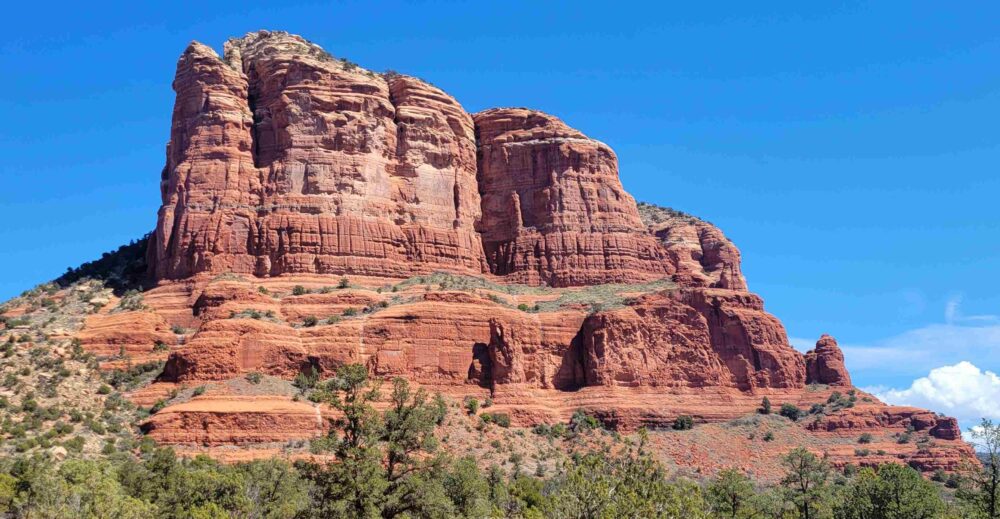
The tail end of Spring Break combined with our close proximity to Phoenix meant that trailheads were all very busy and it was hard to find parking. But we finally found a couple of great hikes away from the crowds. In addition to spectacular rock formations and the bankfull Oak Creek, we saw a few Brown Elfins, Point-leafed Manzanita as they are in southwest New Mexico. The big prize for me was the ‘Navajo’ Yucca Giant-skippers bombing around a yucca-studded hillside behind our campground. I think they may be the largest of the various YGS subspecies. The occasional Painted Lady flapped overhead in a northerly direction.
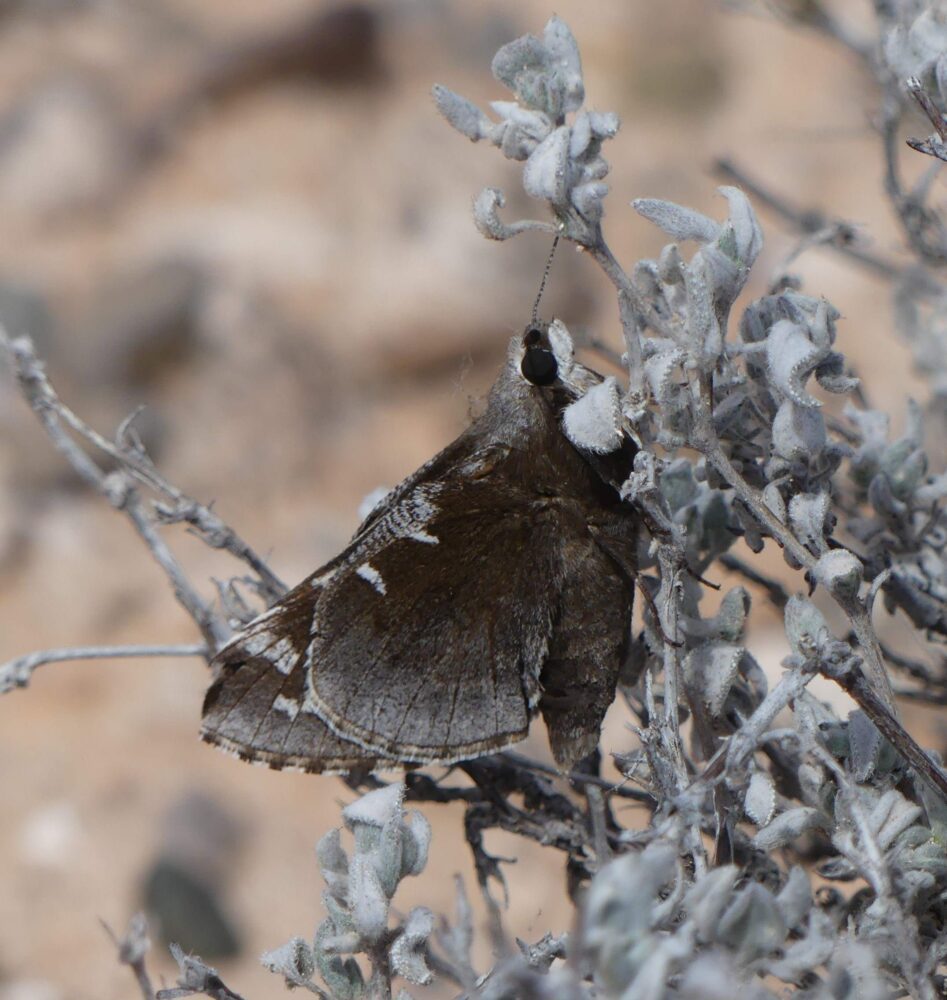

Always watching the weather ahead, we saw that a storm would come onshore on our intended travel day to San Diego along a route that took Interstate 8 over a curvy pass where we and our lightweight trailer could be vulnerable to high winds. We decided to beat the storm to the area, which has become a pattern for us, but it was better than waiting a day and arriving late to our dog-sitting commitment. We efficiently packed up, left Dead Horse Ranch State Park a half-day early and headed for Yuma. There, friends Swen and Deb found weary us a terrific place to camp, then kept us in good company until bedtime. The next day we safely transited the Jacumba Mountains and coasted down into San Diego.
Marcy’s sister and her husband, who live in southern California, had asked us if we wanted to mind their house and dogs in the March-April timeframe. We were happy to oblige so we could escape Santa Fe’s squirrelly early spring weather and, fingers crossed, enjoy SoCal’s good shoulder season weather. Plus, the recent winter’s abundant rainstorms in southern California deserts offered the tempting prospect of wildflowers and butterflies.
Our first hiking outings were centered around Palm Desert, which may be under-appreciated for its abundant and outstanding hiking opportunities. Its complex terrain spans 10,000 feet of elevation, so it is possible to find something suitable almost any time of year. We try one or two new routes every time we visit. Some even lead a person to butterflies! Weather forecasts suggested highs in the 70s all week, and that’s about as good as it gets in “the Desert.”
On March 26, we headed to Big Morongo Canyon Preserve a few miles away in San Bernardino County. At about 800 feet elevation, the canyon’s cottonwood forest is a popular destination for hikers and birders, and therefore a good place to chase butterflies. Some trail segments were closed for repairs due to recent storms, but we worked our way around the place and enjoyed it a lot. Butterflies did not disappoint. Sara Orangetips (West Coast cousins of New Mexico’s Southwestern Orangetip) were out in good numbers, and we saw several courtships. The trail along Big Morongo Canyon showed us about a dozen species, including the familiar Mylitta Crescent and the unfamiliar Gabb’s Checkerspot, a close relative of New Mexico’s Sagebrush Checkerspot. I also got my first-ever view of Northern White-Skipper, but it was not a good photo opportunity. And of the occasional Painted Lady flapped overhead in a northerly direction.

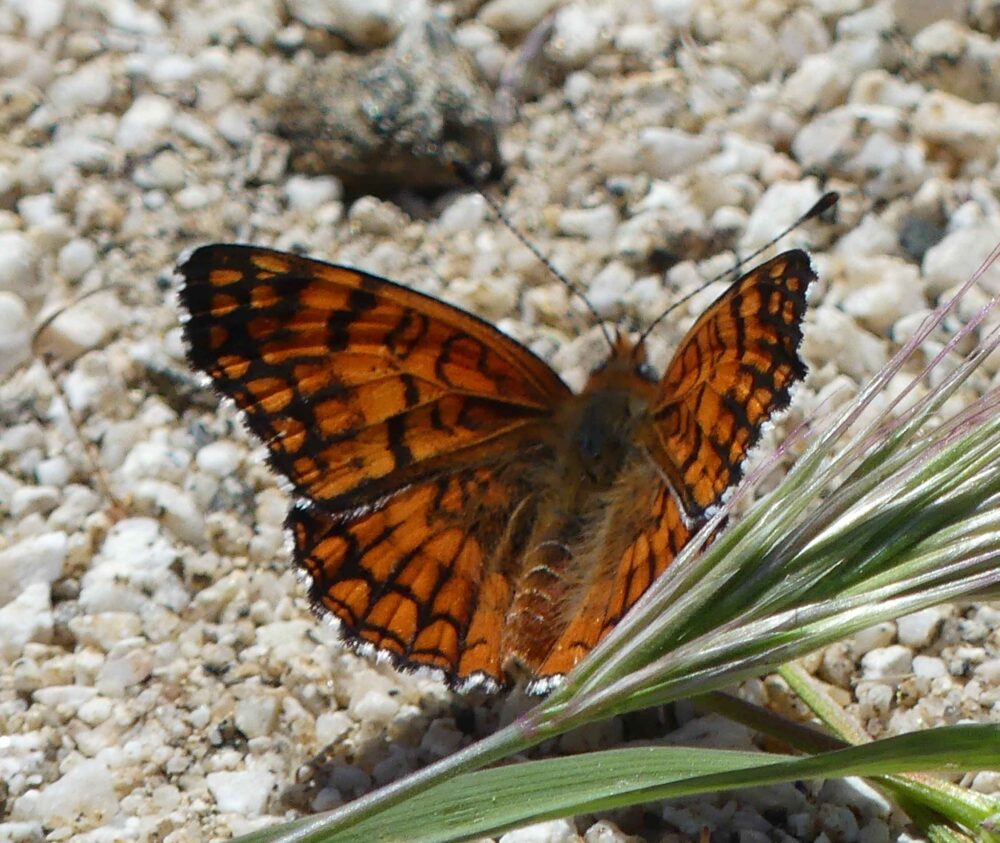
The next day, March 27, I did a solo hike on the Cactus Spring Trail. The trailhead is a few miles south of town on CA74, near the saddle between the San Jacinto Mountains and the Santa Rosa Mountains, From near the highway. Of moderate difficulty, the trail walks a person due east into the Santa Rosa Wilderness. I never get very far because of the interesting butterflies I see along the way. Back in October 2020, I walked a short distance along the trail and photographed Stephens’ Giant-Skipper and Dammers’ Dotted-Blue, two lifers. The site has burned lightly since then, but butterflies have not suffered much, in my opinion. This day I walked up the slight rise near the trailhead and was rewarded with lots of early morning activity including Anise Swallowtail, several Spring Whites, several duskywings later identified as Afranius, and a few Lotus Hairstreaks – which I had never seen before. The photo below shows one that is imperfect, but so fresh that it radiated emerald. I left the hilltop and made progress along the trail, but butterflies were not numerous. After about 15 minutes I reached a shrub that was in the sun and in full bloom. It only had two butterflies on it, Brown Elfin and what iNaturalist eventually identified for me as Loki Hairstreak. Three hairstreaks including two lifers? It’s hard to imagine a better day than that! The occasional Painted Lady flapped overhead in a northerly direction.
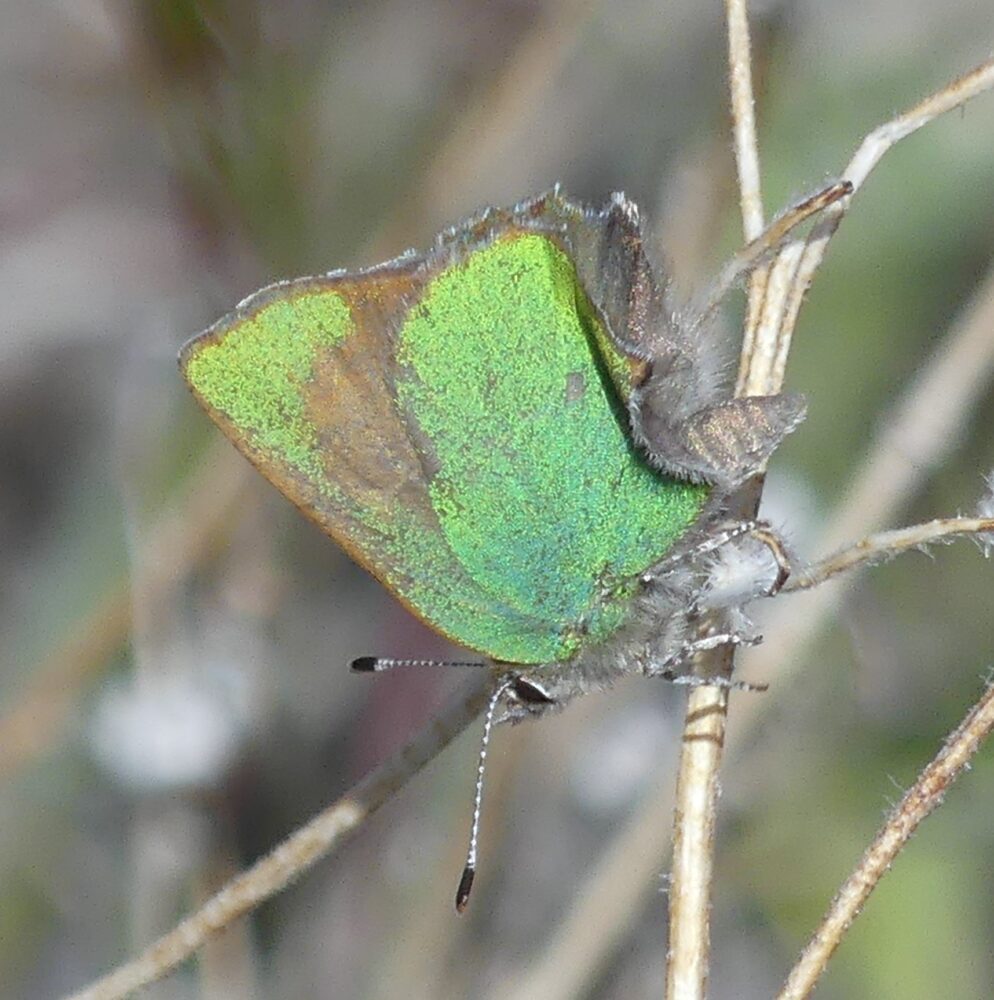
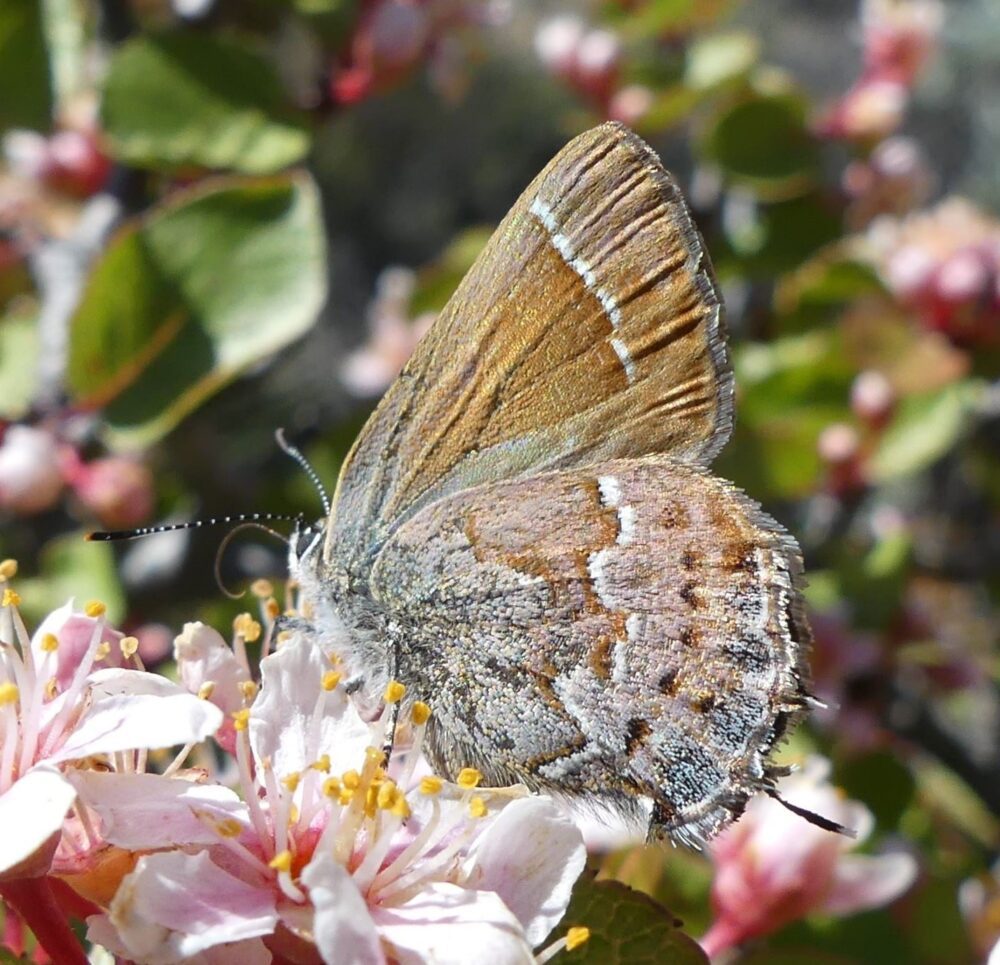
We saved March 28, which was forecast to be a blazing 80 degrees, for the wettest hike of our stay. We hiked the Murray Canyon Trail in May of last year, when it was unseasonably cool, and the butterflies were pretty good. Under the jurisdiction of the Agua Caliente tribe, the area is a well-run collection of outdoor recreation opportunities for which a small day use fee is required. The hike along a perennial watercourse with occasional stands of palm trees at 1000 feet elevation is not something we get to experience in our New Mexico lives. Bring footwear that is Ok getting wet. Given the setting, one might expect some odd butterflies, and I did see California Dogface there last year. This time (a month earlier) we saw familiar things: Northern White-skipper, Eufala Skipper, Pale Swallowtail, plus the occasional subtropical sulphur. A Painted Lady flapped overhead in a northerly direction.
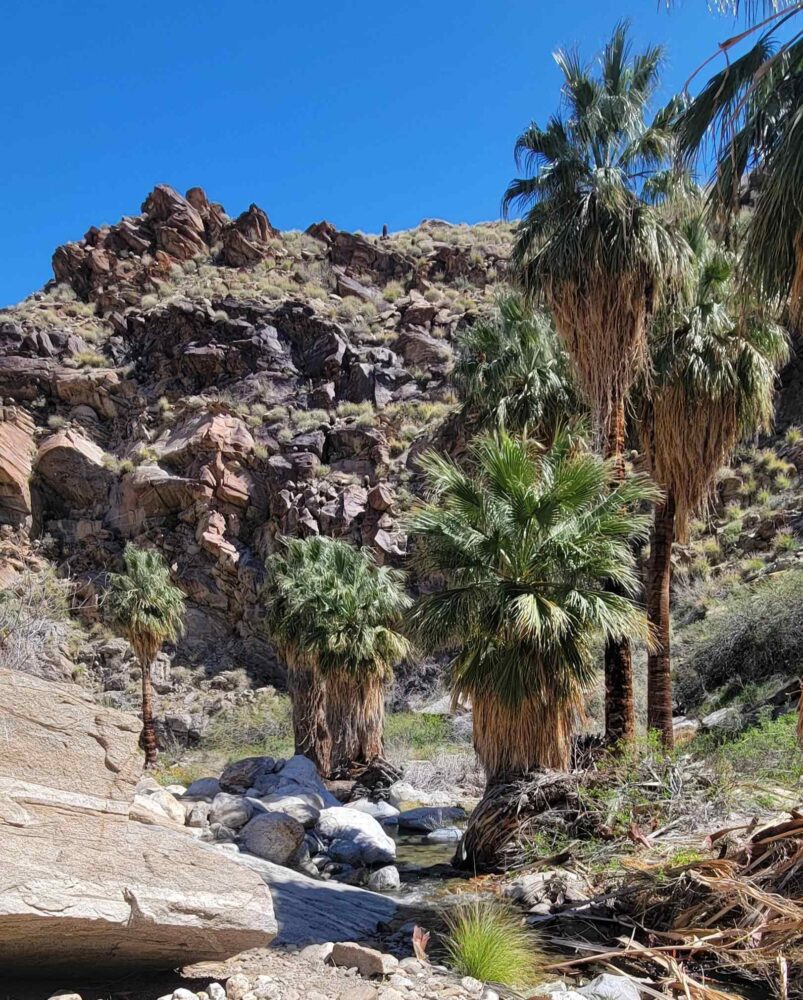
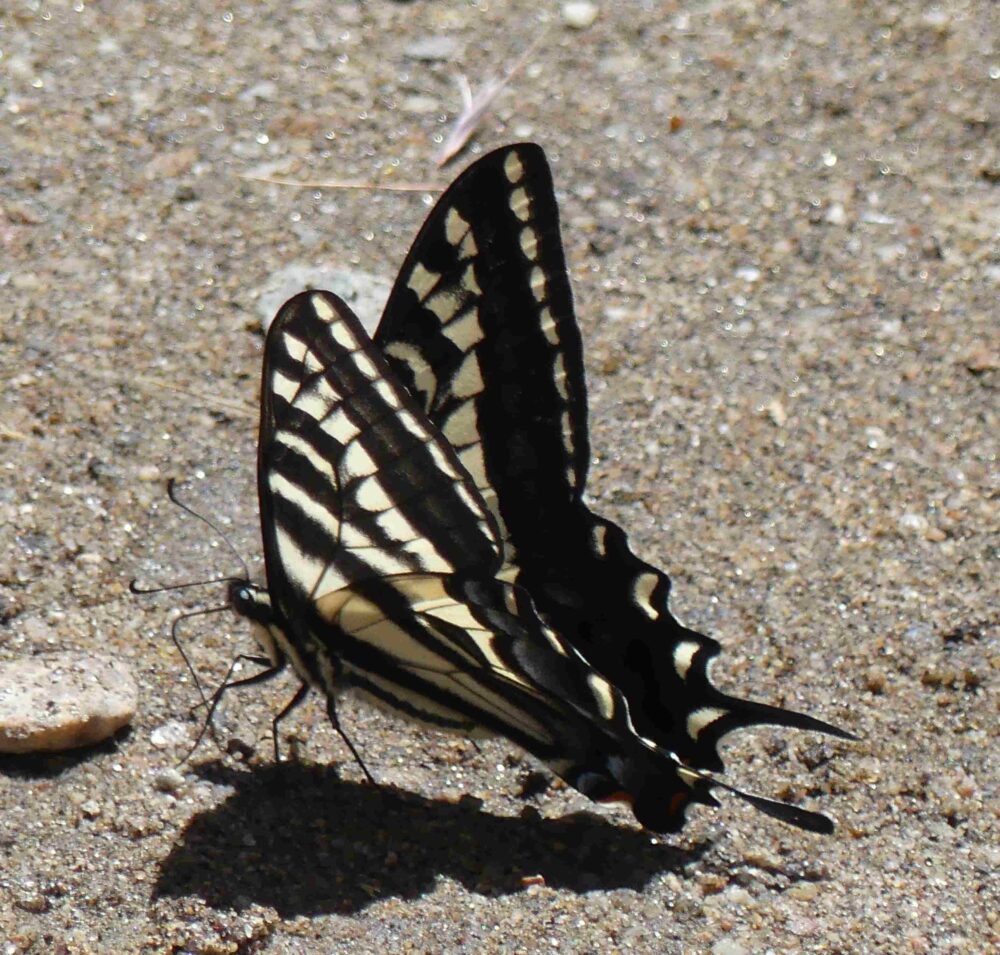

The next day was cloudy and rainy, but hey, we were traveling back to San Diego, so go ahead and rain! Our week in San Diego was highlighted by a four-day drop-in by my sister Kitty, who lives in Colorado does not get to see ocean very often. During her stay we made three visits to sunny local beaches, experienced sea lions in the mating mood, ate lunch at the glider port, and shared abundant poké and fresh seafood. The day Kitty left, the weather turned foul again; I guess it was sad, too.

Anza Borrego Desert State Park, barely two hours from coastal San Diego, was the first stop on our week-long return leg to Santa Fe. We ascended the mountains and then descended into real heat – mid-80s – and found our campsite at the Borrego Springs campground. We hoped the timing of this two-day visit might plop us down in the midst of the second wave of (late) spring wildflowers in the desert. We hiked two or three different trails each day and really got our money’s worth. Our first outing was to Alcoholic Pass Trail, which was neither long nor difficult, but it gave us some elevation and some long views. It also had some cactus blooms, not the least of which was the barrel cactus. Butterflies were generally ordinary and infrequent, but upon returning to our truck I was lucky enough to find a Lycaenid nectaring at the base of a profusely flowering shrub. It was too small for me to ID in the field, but it later proved to be Strymon istapa. Not a great photo, but the first I have seen in the US.
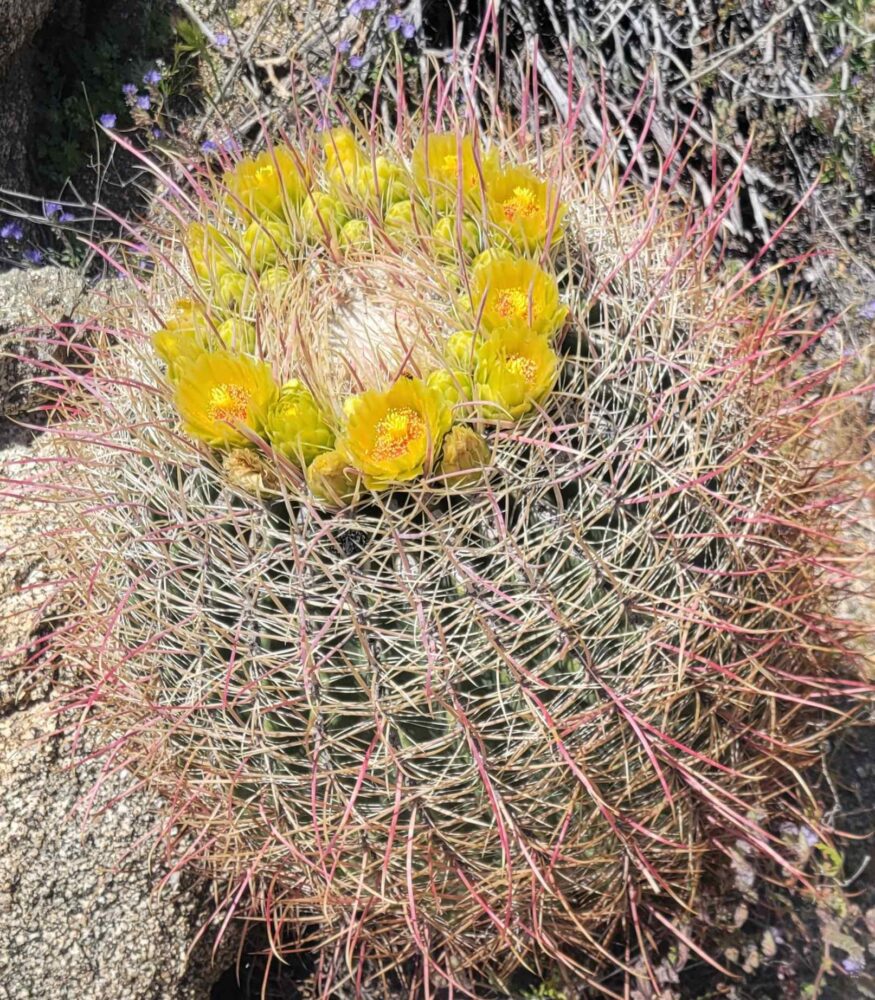
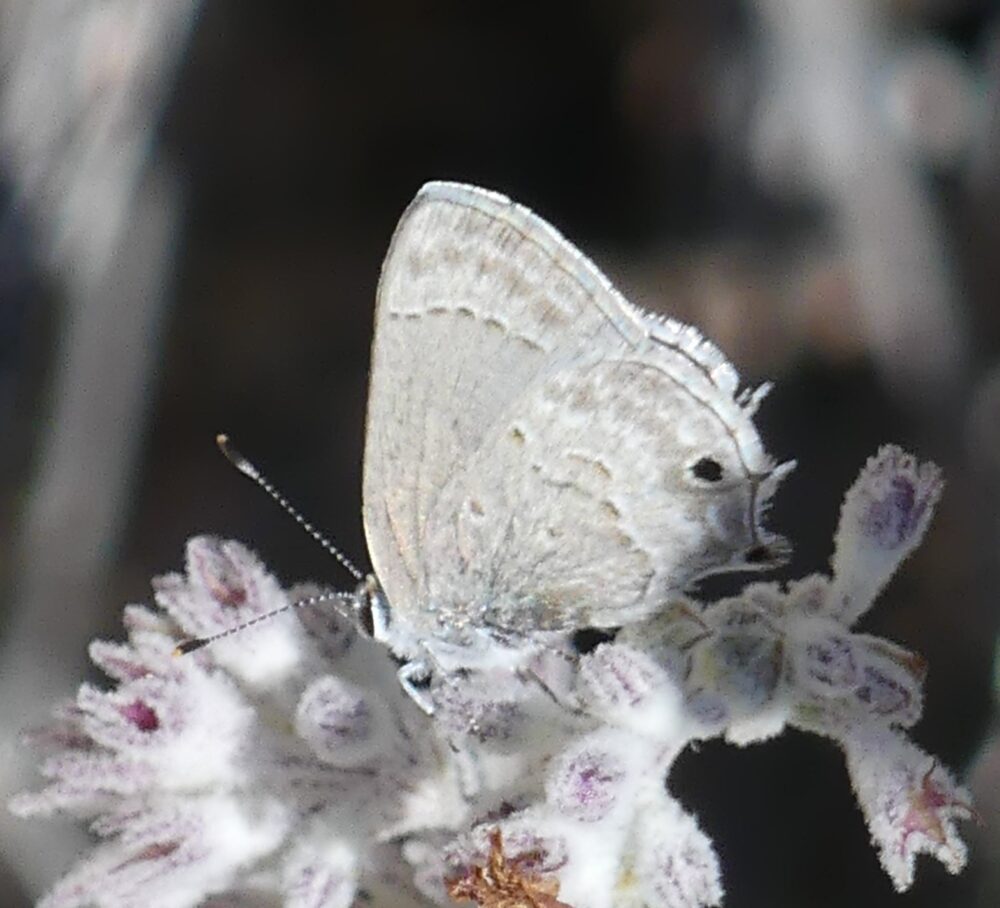
The morning was warming up quickly, so we hustled over to our mid-day destination. En route and at the appointed hour, we pulled over and experienced the eclipse. Several friends had traveled to Texas and elsewhere going for the total version, mostly with success. We only saw 63% coverage, but it was excellent, nonetheless. For me, every eclipse is a reminder that smart people have been accurately predicting eclipses for thousands of years. How did they do that?
Suitably amazed, we next found our way to Glorietta Canyon, which park staff had recommended as having great wildflowers. That proved to be an understatement. Glorietta Canyon Trail was really hopping; we caught it just right in terms of wildflowers and butterflies. Early April was too late for early spring annuals like California poppies and scorpionweed, but there were battalions of other flowering plants getting busy in late spring. Many cactus species were in bloom; ocotillos were in profuse bloom; and many perennial forbs such as penstemons and globemallows, really colored up the desert and roadsides. Then there was a variety of usually non-descript shrubs, which I don’t ordinarily think of in terms of flowers. Individually the flowers were not large and beautiful, but they were so numerous on several shrub species that neither we nor the abundant pollinators could ignore them.
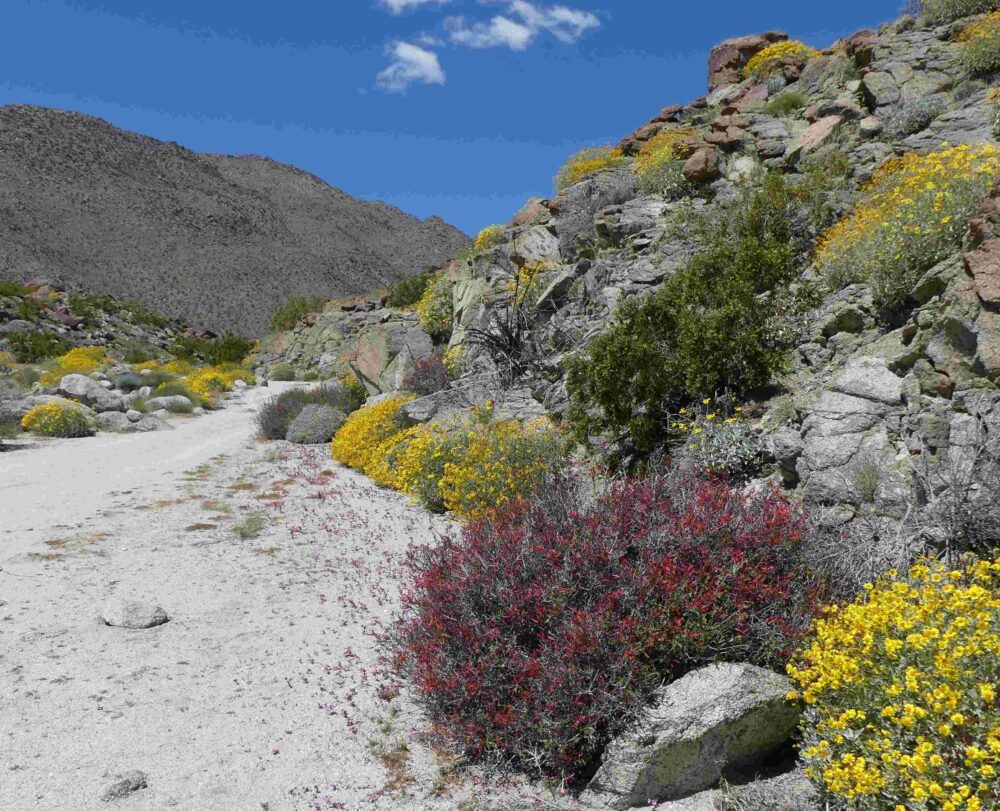
This, our best butterfly spot, produced at least a dozen species, not all of which I was able to confirm by eye or by photograph. The ones that stand out in my memory are Arizona Powdered-skipper, Juba Skipper, Tiny Checkerspot and Wright’s Metalmark. The checkerspots were all over the place; we must have seen more than 200. For the metalmark, I spotted it perching and patrolling from a small shrub right along the trail. My attempts at photography were stymied by other hikers. on our return back down canyon it was in the same place, but less agitated, so I successfully got my first decent (not edge-on) photos for this species.
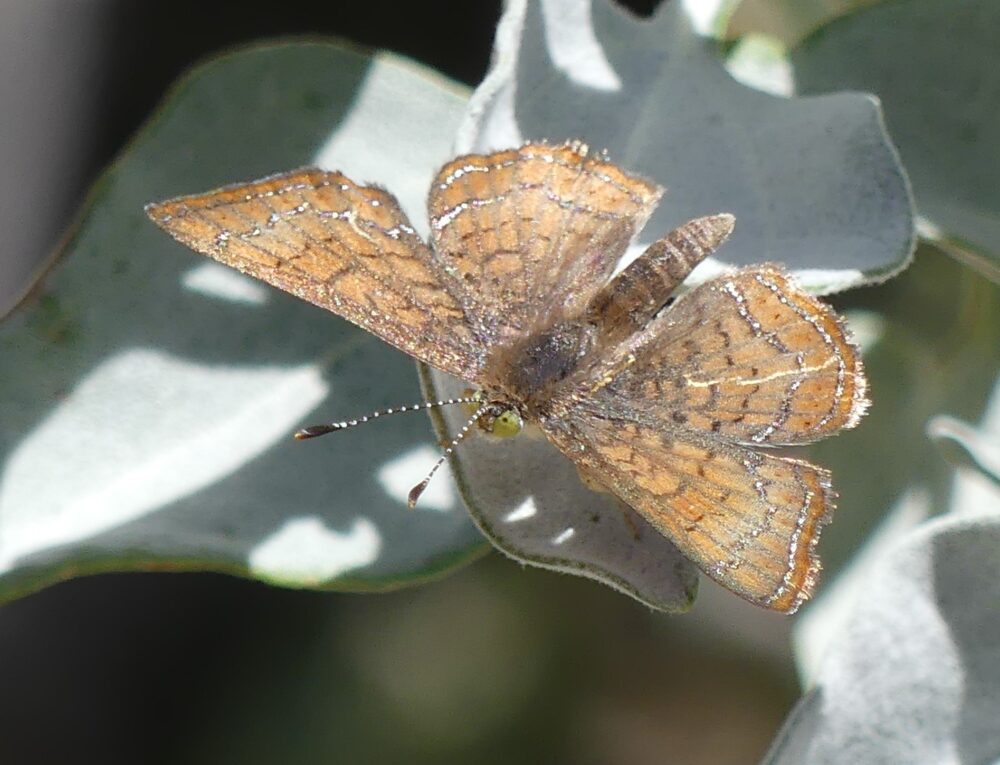
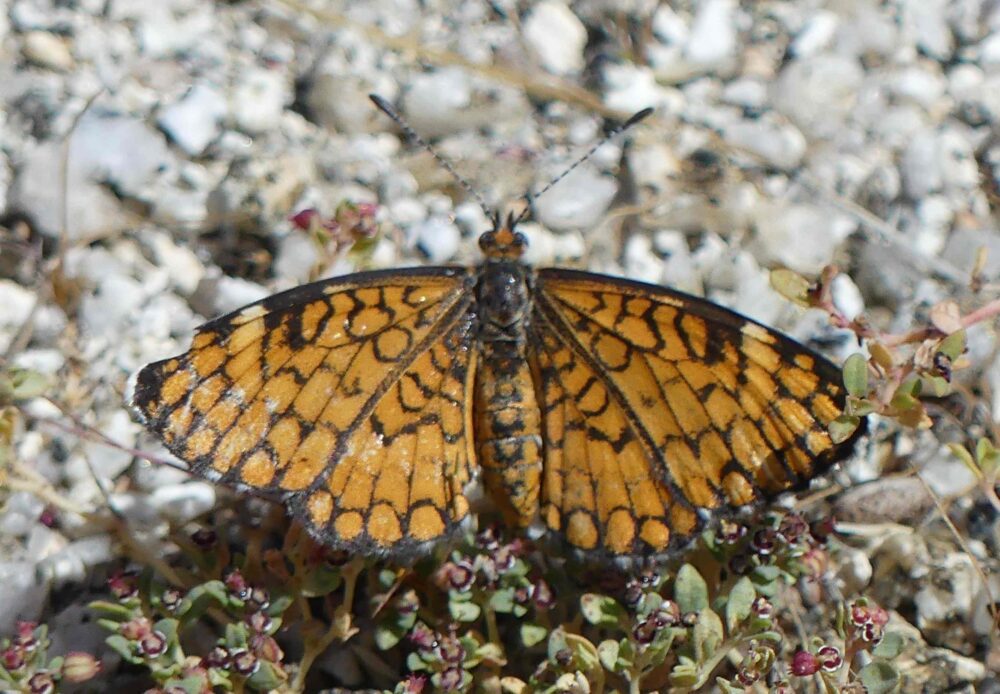
The next day we went looking for interesting geology, specifically “The Slot” — a narrow, meandering defile eroded into volcanic rocks by the infrequent but powerful winter storms that leave their marks on the region. It was quite impressive (also cool and shady) and gave us another perspective on the region. Our enjoyable time at Anza Borrego came and went a little too quickly for us both. Hotter weather was coming though, so maybe we spent the right amount of time there.
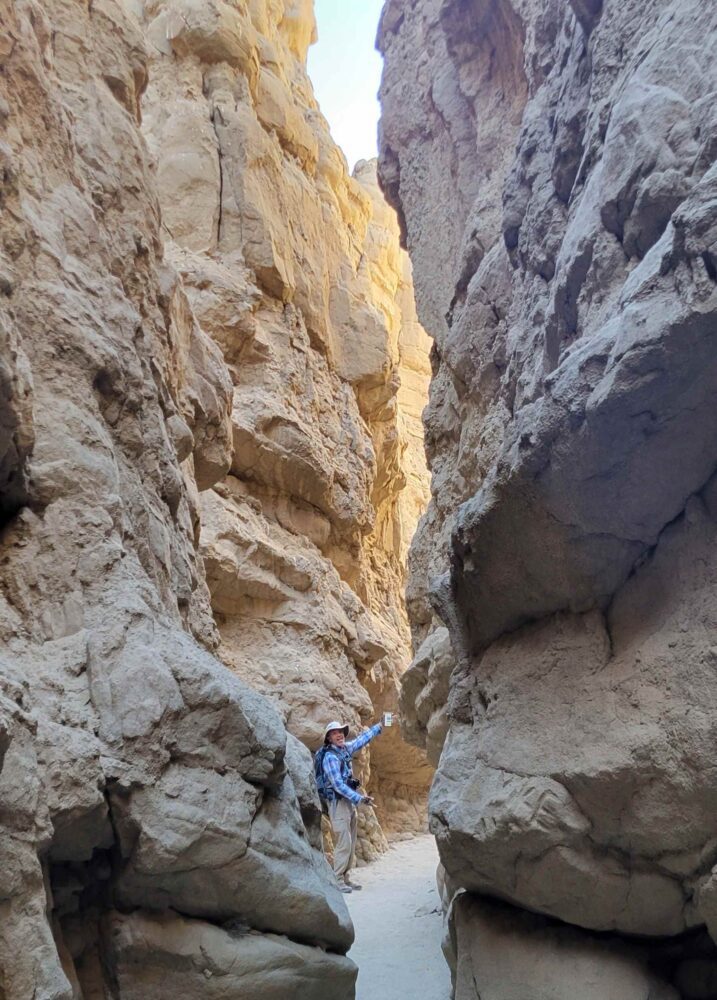
Our next planned multi-day stay was near the surprising little community of Portal in the Chiricahua Mountains in southeast Arizona. There, we met up with friends Karen, Tracy, Holly, Susan and Craig, in kind of a reprise of last year’s event. The 2023 gathering had been a couple weeks earlier on the calendar, and high runoff kept all the creeks high and prevented us from executing the hikes we had planned. This year it proved to be better. We hiked terrific trails during the day and shared evening happy hours and meals. Birders searched for the trogon in vain, while I searched for butterflies, largely in vain. We did turn up one Juniper Hairstreak, one Brown Elfin, one White-barred Skipper and one Mexican Azure, but there simply was not much flying. We had a lovely time, nonetheless.
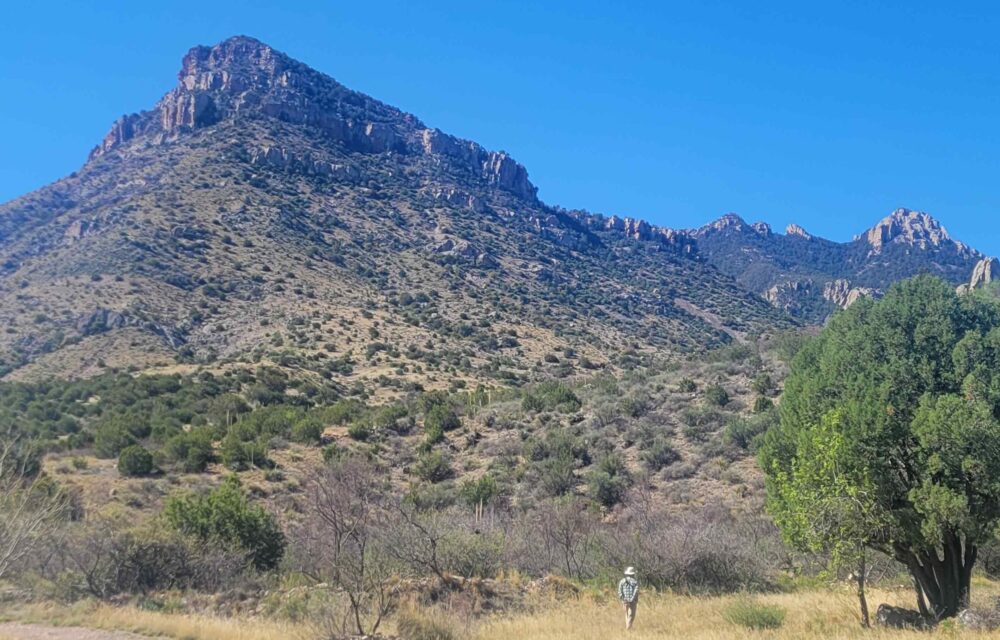
The day before we decamped from the Bootheel to head home, Marcy and I drove south to Douglas, AZ, to get gas, then northeast toward the Peloncillo Mountains, New Mexico’s southwestern-most mountain range. It is always in my mind that this area, though considerably less majestic than the Chiricahuas, is nevertheless a place to find unusual butterflies, but it is so far from our Santa Fe home that it is not very practical to go there. However, being in the area now, I could not return home without giving them a decent look. What impressed us was the ruggedness of the area; trails were very primitive compared to those in the recreation-oriented Chiricahuas. l expect the chief users on the New Mexico side were ranchers and hunters, often on horseback, so pedestrian trails may not be a priority.
We parked at Geronimo Pass, the high spot on the road (currently Geronimo Trail and Hidalgo County Road 0004 in New Mexico) that meandered east and down into the Animas Valley. From the parking area at the pass, we could see a crude trail going south and up. That suited me fine because I wanted to find a hilltop. We carefully clambered up to the gnarly ridge. Conditions were not great for butterflies – cool, dry and windy – but we did see a few spring hilltoppers, including Desert Marble and Burgess’ Duskywing.
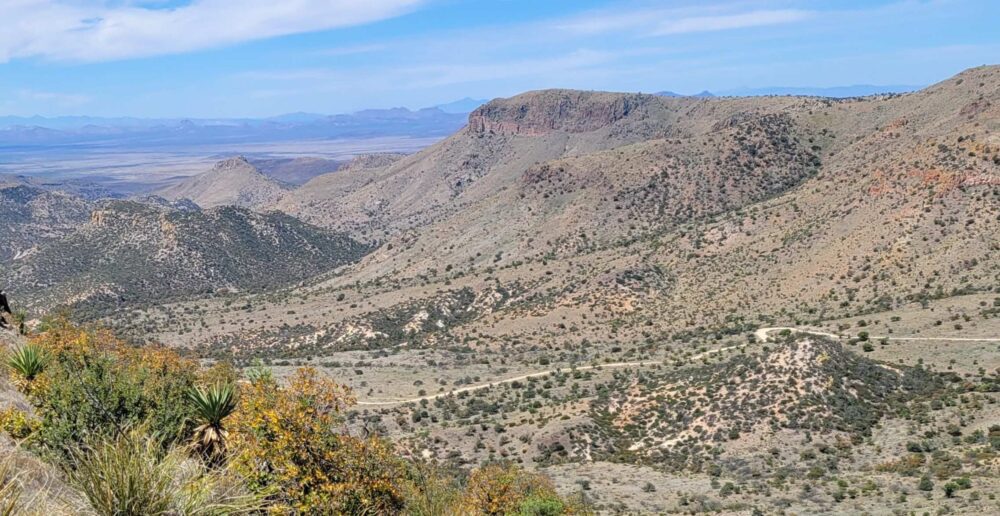
Then we retraced our steps back to the truck and continued down-valley into Clanton Draw. The only other butterfly that impressed us was Juniper Hairstreak, of which there were several fresh individuals nectaring at fleabane – just their size. Although most of my photos were not worth keeping, these scant few familiar species made me feel right at home, back in New Mexico.

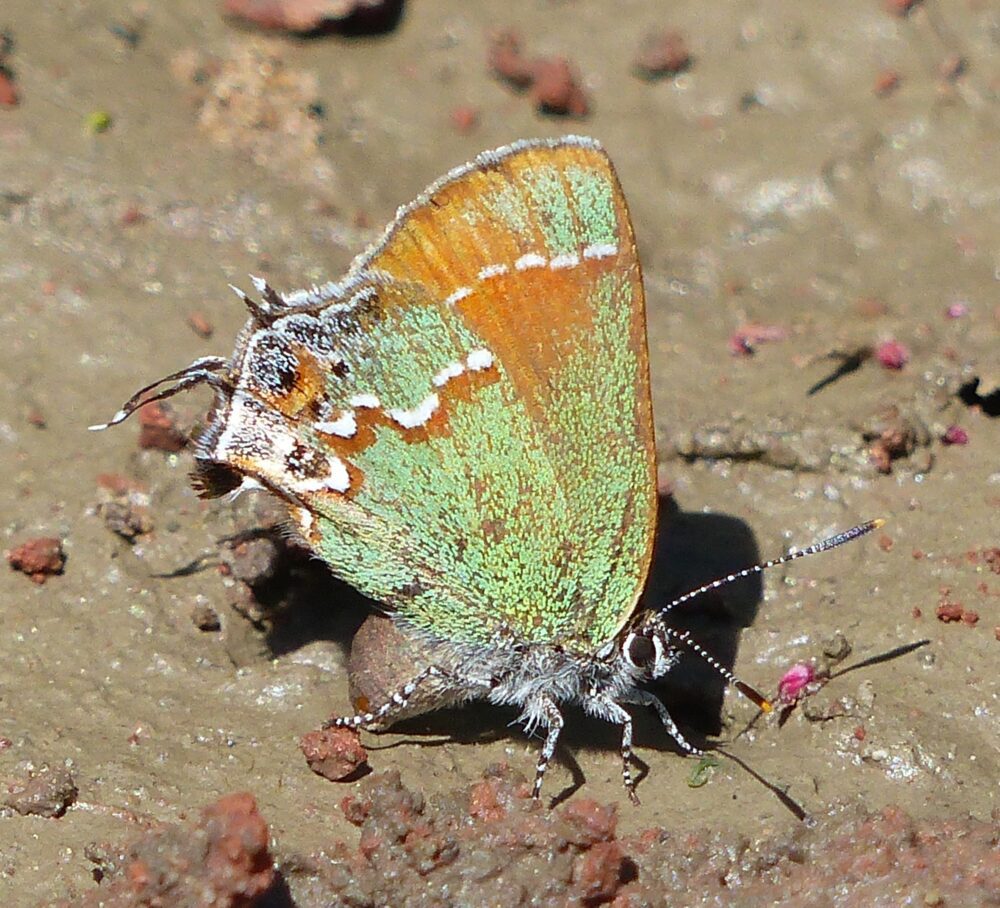
The remainder of the trans-mountain route across the Peloncillos showed evidence of a recent serious wildfire, probably the Foster Fire of May-June 2022. Much pine forest was burned hard – very sad. But further exploration away from the main road might reveal intact pine forests elsewhere in the range. It only needs to be explored. Reason enough to come back soon.
From there, it was all a blur. North to Animas, west back to Rusty’s, pack up and then hit the road fresh the next morning. Eventually home, sweet home!
Last but not Least. . . . At least in northern New Mexico, butterflies have been present in seemingly normal ways this spring. Winter precipitation was semi-normal; we had no extended periods of extreme cold or extreme heat; snowpack in the Sangre de Cristos was close to normal, though the melt and runoff seem to go pretty quickly. Butterfly outings targeting spring butterflies are always vulnerable to the usual vagaries of spring weather. But you always know what you will see if you stay home, so you check weather forecasts, design your effort accordingly, then get out there and hope for the best.
On April 29, I visited one of my favorite New Mexico State Parks: Heron Lake, in Rio Arriba County. It’s a 2-hour drive from Santa Fe. Recent news reports of flooding associated with the Rio Chamita, a tributary of the Rio Chama, gave me hope because that could only happen if winter moisture was normal or better. When I arrived in the Chama valley, I found its grassy meadows to be almost as green as it used to be every spring, as best I can remember. Streams were flowing well; stock ponds had water. It was like a trip back in time.
At Heron Lake State Park, I like to look for butterflies at a couple particular spots in the park. The strip of land between State Highway 95 and the Rio Chama gorge, west of Heron Dam, is such a place. It is locally called the “pygmy forest” because of all the stunted ponderosa pine trees growing in the challenging basalt-covered ridge. Some allege that these pines escaped the regional lumbering of the early 20th Century because their small size and twisted shapes rendered them not worth the effort. A gnarly pine savanna has room for sun to get to the soil and grow other plants. It also makes for rough walking, sturdy boots (and knee brace for me) required.
You may recall a blog post from last spring detailing my April 16 visit to this place, when I encountered an orangetip which eluded my photo attempts and almost sailed me over the cliff into the Chama. This year I wanted to try again because I don’t know if that orangetip was Julia or Southwestern. I arrived at about 10:30 AM and it was not as warm as forecasts had implied . . . 52F was what my truck thermometer said. But it was sunny and it was spring, so I parked in a pullout at about 7000 feet, booted up and started up the basalt slope. I warmed as I walked (uphill hikes will do that). I was aiming toward the highest point on this piece of ground, about 7500 feet per the topo map, where I hoped there would be a respectable hilltop because, you know, orangetips are hilltoppers.
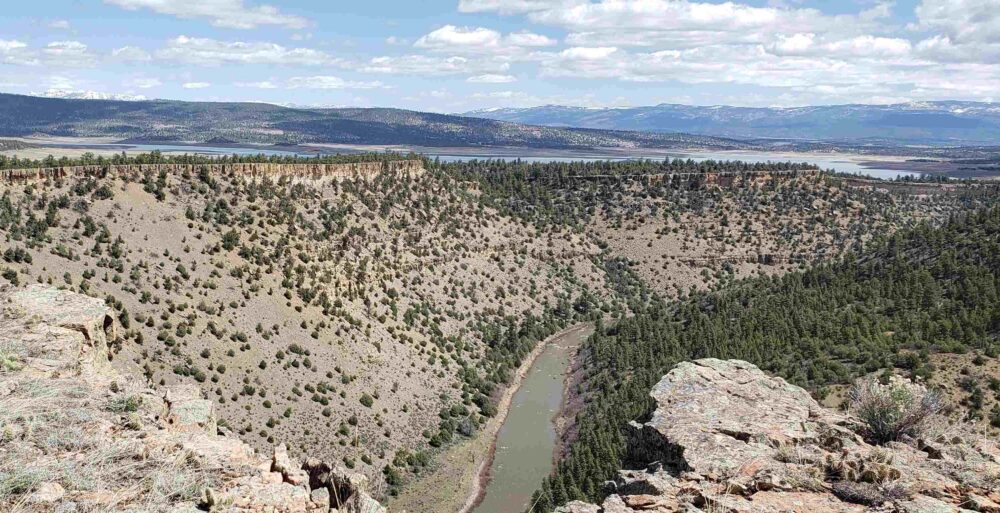
It was probably 15 minutes before I saw my first butterfly, a northbound Painted Lady, and a blur even on this cold morning. My continued upward progress through pine savanna produced a Spring White and I suddenly felt relieved that it would be warm enough for butterflies after all. More butterflies appeared as I slowly neared the high rim of canyon, this time a Burgess’ Duskywing, another avid hilltopper. I continued up the gentle slope toward the unnamed high spot, trying to stay near the rim, but not TOO near (a 600-foot drop gets my full attention). The summit was not particularly prominent, but several butterflies had no doubt whatsoever. Nothing was there in great numbers, but there was regular patrolling by what you might call the usual suspects: Painted Ladies, Spring Whites, Burgess’ Duskywings, and my favorite of the day Anise Swallowtail. It posed nicely while basking in the cool sun, which I took as a good omen for the butterfly season in this area for foreseeable future.
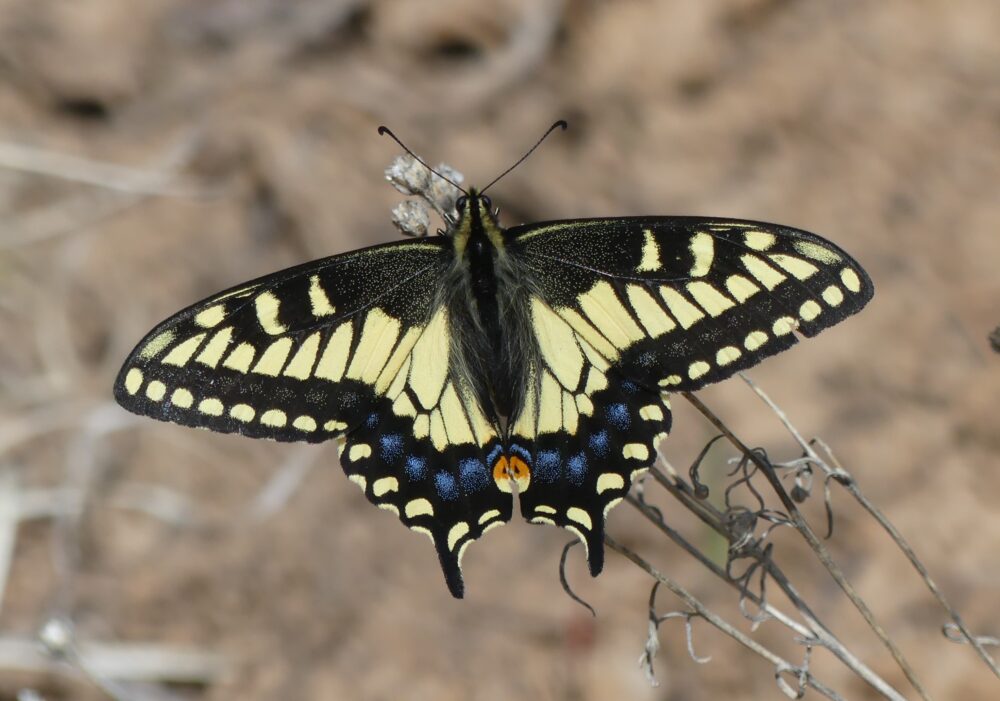
In the end, I saw no orangetips, but I was two weeks later than last year, so perhaps my timing was off. I plodded slowly back down the irregular basalt slope toward the road, where a few Western Clouded Sulphurs (Colias eriphyle) were becoming active in the roadside vegetation. Then, driving back toward the dam and other destinations, my vehicle’s thermometer stabilized at 59F. Spring flying butterflies seem able to extract enough heat from the sun to fly in air temperatures that would chill and immobilize many other species. A good lesson!

I enjoyed reading about your trip very much. Not a “snory” at all.
thanks, Rebecca :^)
Thanks, Steve – a nice set of stories for a beautiful/interesting part of the US! Springtime visits to Anza-Borrego Desert and Torrey Pines are a staple when I travel to SD, brings back memories of surf fishing at Bathtub Rock in the 70s! Should you travel San Diego way again, I’d suggest Point Loma trail systems, as well. Congratulations on your successful butterfly pursuits with excellent supporting imagery! Jim
Oh, that’s your old stomping grounds? we also did some Point Loma trails, just can’t fit it all in. Your kind words are much appreciated.
Love it!!
Beautiful photos! Are those human butterflies you photographed at the Torrey Pines?
yes indeed! you know the place?
Steve- beautiful photos, thanks for taking us along with you on your trip. You made the areas visited come alive. Joe N.
thanks, Joe!
thank you, joe!
Wonderful blog. I am most envious of your Anza Borrego hiking through the slot canyon and flowers. I have always wanted to go there when the desert was blooming.
Thanks, Rozelle. We were lucky and timed it well.
Thanks for the post. 50+ years ago I did some geology field work in the Anza-Borrego slot for an undergrad geology course. Your photo reminded me that I need to go back there.
the area shows us more good stuff every time we go.
Bob, it’s amazing how you and many others have a connection to that place.
Good to hear people are having some good luck this spring. Thanks for the inspiration to get out there and explore.
Kelly, we were lucky to see some good stuff. Much of New Mexico is not having that experience this year.
Nice descriptions of place and lovely photos of such a nice variety of butterflies. I’m not having a lot of luck photographing Baird’s females right now. I did have one visit the yard, but scared it off the Wild Tarragon in my excitement to get a decent photo. I shan’t concede defeat so easily though! Love the Blues and Duskywings you got photos of.
Krista, it’s great to hear from you. I’m glad you enjoyed the post. Please do persist in your efforts to get Baird’s at wild tarragon. and if you have some other butterfly story to share, I’d love to consider it for a future post.
Hi Steve. What a wonderful collection of photos…of butterflies and landscape! Makes me want to get out and exlore. Thanks for the inspiration.
Thanks, Randy. The best thing to do with inspiration is to pass it on.